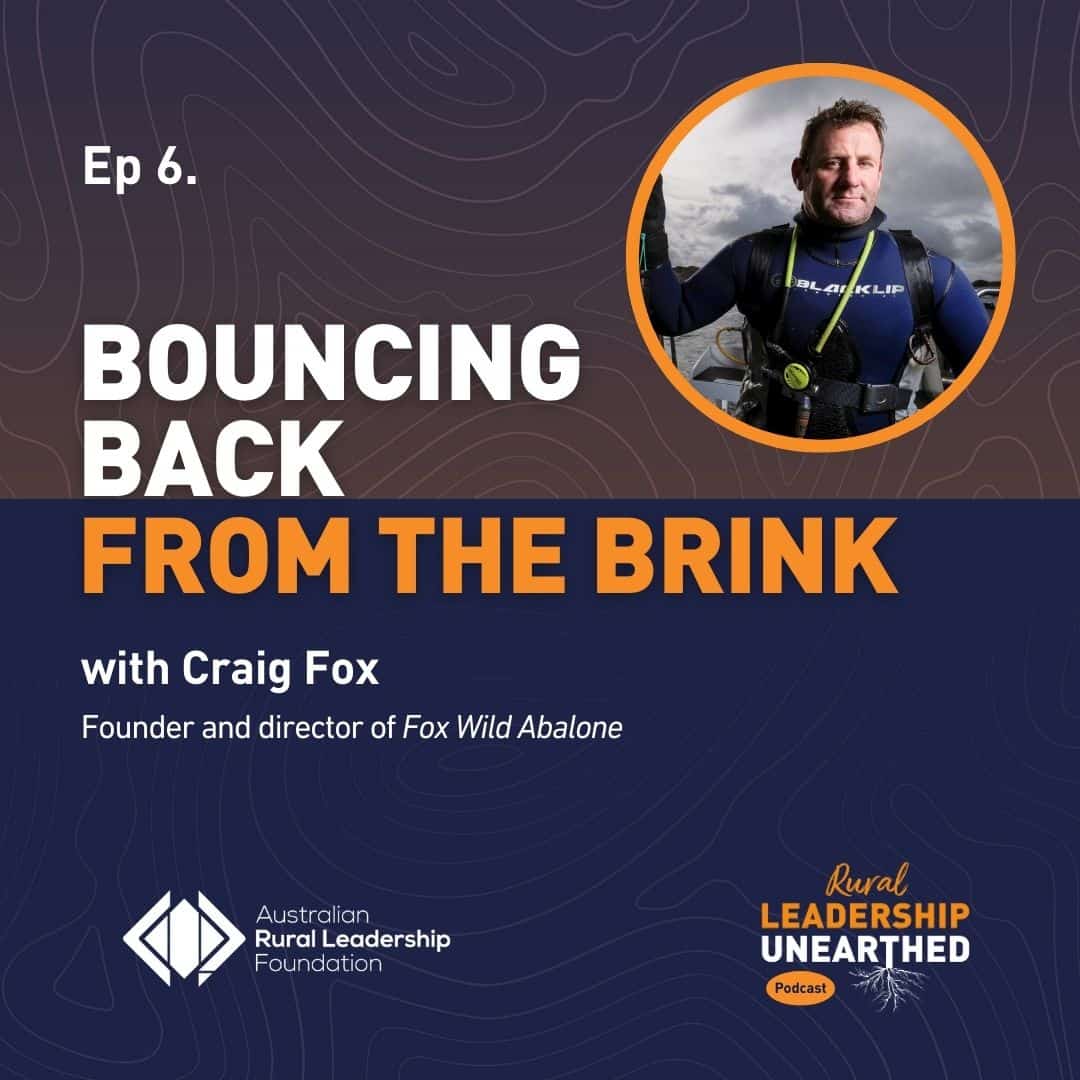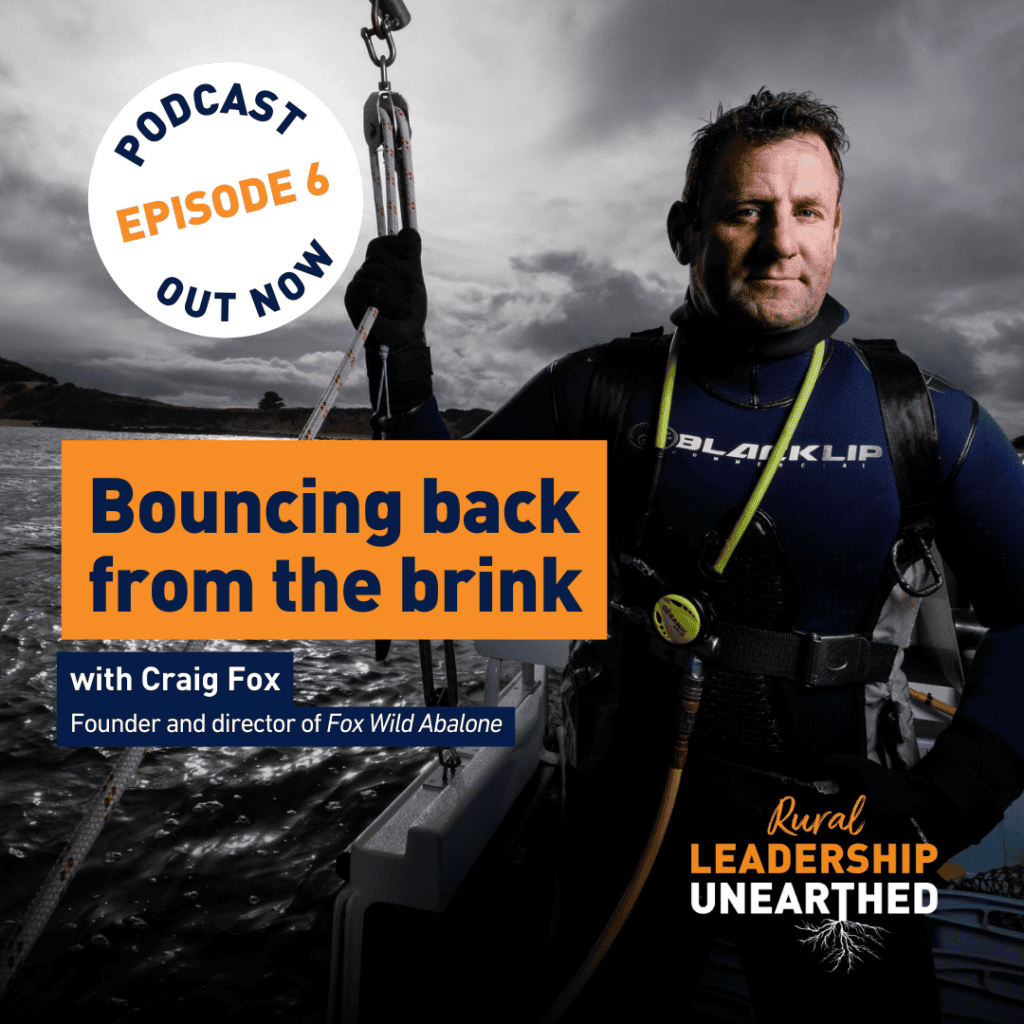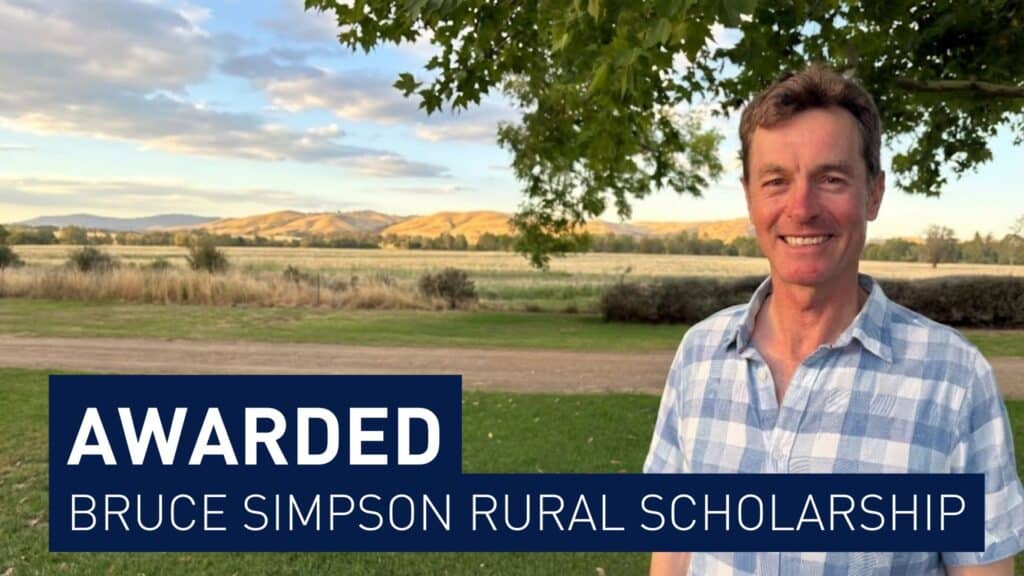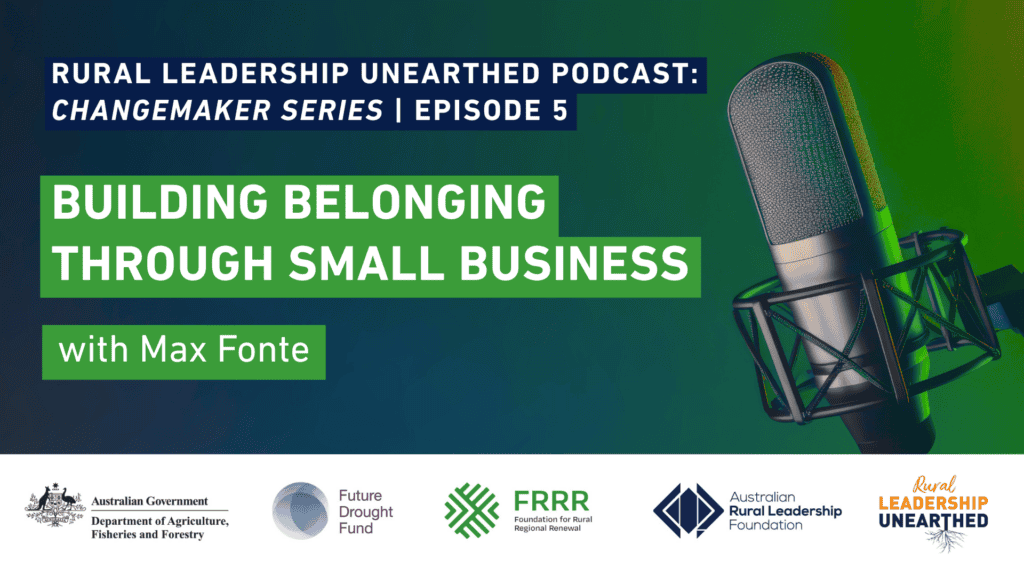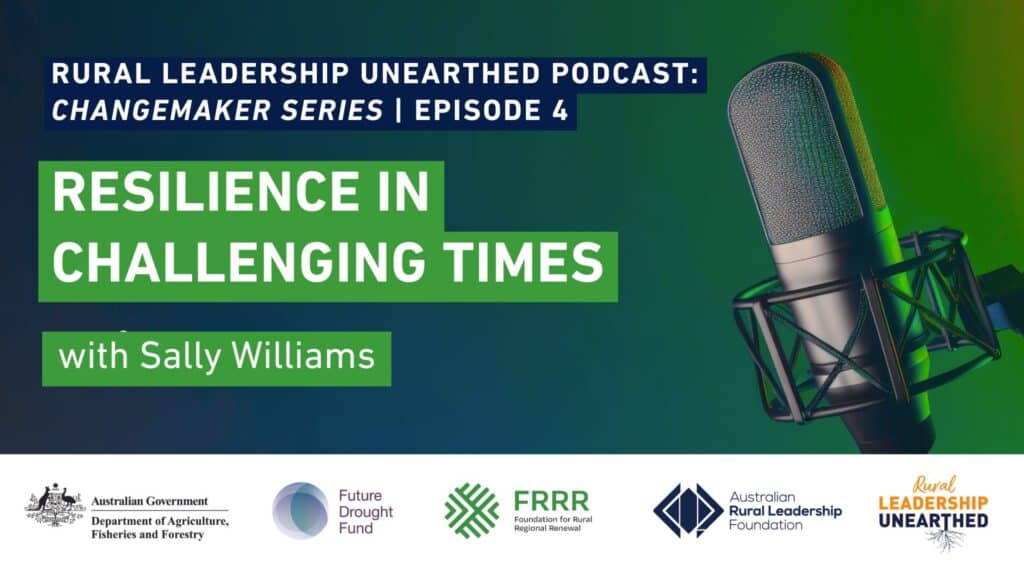Craig Fox has an innate love of the ocean. He’s been at home out on a boat or under the waves since his career in commercial fishing began as a crayfish deckhand in Port Fairy at age 16. When he discovered abalone diving in his twenties, he knew it was the industry for him. Today, he is the founder and director of Fox Wild Abalone, and a passionate advocate for fostering the diversity needed for his industry to flourish.
Sitting down with our host, Claire Delahunty, Craig takes us inside the world of this unique wild harvest industry in the latest episode of ARLF podcast, Rural Leadership Unearthed. He revisits one of the darkest times in his professional life, when a highly contagious outbreak of Abalone Viral Ganglioneuritis (AVG) swept through the industry’s Western Zone. He speaks about the devastating emotional and financial impact, and the collective leadership the fisheries sector showed to recover and rebuild.
As we mark World Ocean Day 2024, Craig talks about the perspective his work gives him on healthy ocean environments, and the importance of telling the story of Australia’s world-leading seafood industries. This year, the busy leader will also take part in Course 31 of the Australian Rural Leadership Program, thanks to a scholarship from the Fisheries Research and Development Corporation.
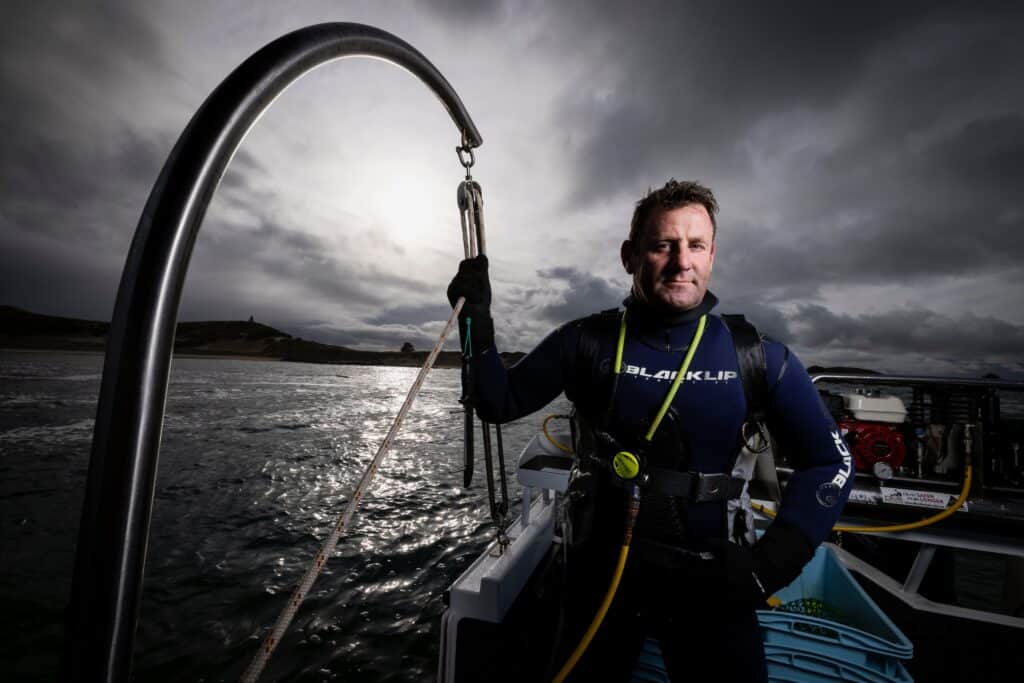
Claire Delahunty: Would you mind telling us a bit about yourself and where you live and what your office looks like? Because it’s not your typical one.
Craig Fox: I live in Port Fairy in Victoria down on the west part of the coast. I’m a commercial abalone diver and my office from day-to-day changes obviously and involves a lot of underwater scenery.
CD: What got you into the industry?
CF: I started fishing at the age of 16, but my cousins were both fishermen. So my immediate family weren’t from a fishing background, but on school holidays as a young boy, I’d come down to Port Fairy and I’d get to go on my cousin’s cray fishing vessel. I just loved it from a very young age. I knew that was what I wanted to do. First, I thought I just wanted to be a rock lobster fisherman. Over time, as I started my career, I saw the local abalone divers working here in Port Fairy and got really interested in that and then had an opportunity to work with one of those gents and follow that through. Once I started doing that, I knew that part of the fishing industry was for me. I’ve been fortunate to do it ever since.
CD: Do you remember your very first abalone dive?
CF: I do, and it was one of the hardest days work I’ve ever done. I thought it’d be easy. I’ve done a lot of diving, a lot of spearfishing, a lot of recreational diving and I’ve done a lot of cray fishing and a lot of manual work. But my first day of abalone diving, for a quota, I remember coming over with about 150 kilos and thinking, how am I going to catch 20 tonne? This is impossible. How do these other guys do it?
I remember coming home and had never been so tired in my life. It was just swimming out all day and fighting the currents and the weed. But it’s something so different than going for a recreational dive or a crayfish dive. And you’re actually working and finding the abalone in the weed and swimming. All the guys and girls that have done it say the same thing: the first day is a bit of reality check.
CD: And how do you carry it all? How deep are you?
CF: Yeah, look, it is a tough job, but the people that do it, we do it because we love being in the water and we love that ocean environment and it is a unique job. Through hand harvest you’re only picking out the ones that you want. So, it’s a very sustainable fishery. And because we take them to a certain size, they’re the fish that you’re aiming for.
It is a physical job. I wear about 20 odd kilos of lead jacket to keep me on the bottom, and as you fish and you collect abalone, you’re keeping them in a bag, so you’ve got that weight with you as well. We work at different depths, from three meters out to 25. Obviously the deeper you go, the more risk with the bends and a bit harder on your body with the pressure.
It’s fortunate that it doesn’t feel like going to work for me. The things we get to see and witness every day is different. The conditions are different too. Some days I’ll have 30 meters of visibility, some days I’ll have half a meter. And then the different fish species; octopus, seals, dolphins, you just don’t know what’s going to come. It’s still exciting every day that I go to work.
CD: And quite an education in marine ecology and life under the ocean.
CF: Yeah, and we’re probably one of the first to see changes with climate or water temperatures, because the species and the seaweed and the algae change. We see a lot of different fish species over the years that we’ve never seen when I first started diving. And that goes with a lot of the trends that the scientific world sees.
I’ve talked to lots of divers across Australia in different parts of the country and everyone sort of says the same thing. It’s a very unique job and we’re all attracted to it for the challenge. It’s a hard job, but it’s so rewarding as well.
CD: And where is your hand harvested abalone going? Who’s eating it?
CF: It’s always been a very high export fishery. Mostly exported into Japan, China and the like; Hong Kong, a little bit into Canada and places like that. There is a bit of a drive from industry across Australia now to look at more domestic marketing. That has taken off a little bit in the last probably five years, but still the large majority of our product is export. It’s important to the economy, but we would like to see a lot more of it consumed domestically. It’s just not something that has been high on the radar in Western culture, but it is a really good source of protein. It is hard to cook and that’s where people struggle with it a little bit. As an industry, we’re spending a lot of time and effort and money into educating and trying to change that perception.
CD: Can you give us a quick recipe? How should your first taste of abalone go down?
CF: For me, I just shuck it and give it a quick tenderise, like just a quick whack, not too bad. Slice it very thin, salt and pepper and straight in the hot wok and just really quickly flash fry it and eat it. And that’s pretty good.
CD: What was the process like of founding your own business, Fox Wild Abalone?
CF: It is a hard one to crack getting into the abalone industry. I was fortunate enough to be able to buy in. And then I leased a lot of quota as well, or contract dived for other people to make that business sustainable. I catch my own quota and I catch a quota for other licensed owners. I’ve done that interstate as well over the years. With Fox Wild abalone, we wanted to do some of our domestic marketing direct into restaurants and try and highlight the great product that we have and the freshness of it. So we went about it that way, gained the correct permits and the systems to be able to do small sales domestically, straight to restaurant trade or straight to the general public. I think it helps showcasing the small communities and towns where the fishing occurs. That’s an important part of being able to get into local restaurants.
CD: You experienced the impact of the Abalone Viral Ganglioneuritis (AVG) outbreak. Do you mind describing what that was and what it did and what you learned through that difficult process?
CF: Yeah, it was a very difficult time. That occurred in the Western Zone for the first time in 2005. So prior to that, I was just lease diving. I didn’t own quota then. But when the virus came through, we’d never seen that in the wild populations before. It was an exotic disease that our abalone in the wild didn’t have immunity to, obviously.
And unfortunately it went along our coast and moved around and wiped out estimates of anywhere from 70 per cent to 90 per cent of our biomass. So basically over the space of five years, we went from being a 280 tonne fishery in the Western Zone to nearly zero. And then we had to rebuild that. It was a massive challenge for all the divers and all the license owners.
License values and the quotas just plummeted. We went from having 14 divers and 14 owners to four or five divers. Licenses got consolidated a little bit. We had a processing factory here in Port Fairy that employed 30 people locally that we lost because the volume wasn’t there.
No one really knew too much about it, and we couldn’t control it. It’s different than a farm where you might have a biosecurity problem and you can keep things segregated. Obviously in the ocean we couldn’t do that. Then over time we worked out there was human intervention that was actually moving the virus up and down the coast. We’d see jumps of it. First we thought it was just by the abalone touching each other or moving a little bit in the water column. But then over time we started seeing it jump 50 to 100 to 200 kilometres up the coast. It was all new research trying to figure out what to do, and it burnt itself out thankfully. Our priority was then to protect the stock that we were left with. We changed our size limit to make it higher so the fish that we did have left had a longer breeding cycle to reproduce.
We didn’t fish for a little while, but when we did return to fishing, it was a very small amount of quota and more monitoring of stock. Over the years, we’ve been very proud of what we’ve been able to do. We’ve been able to bring it back. Normally with abalone populations around the world, when they face that sort of depletion, they don’t come back. We’ve been unique that we have been able to turn it back into a commercial fishery again and get it going. We got back to 70 tonnes a couple of years ago and we had a tiny outbreak of it again in the Portland area. We’ve just gone through the same thing, but this time around we’re a lot better informed. We knew more about the virus and knew how to control it. We put a system in place where we shut an area down to all types of commercial or recreational fishing, and even surfing for that matter. We just let nature do its thing and it burned out quickly and we were able to contain it to a small area this time.
We’re still doing some heavy research with the Fisheries Research and Development Corporation about early detections like water testing if this is to happen again. It was a massive challenge and it’s one that we wish we’d never seen, but we have and we’ve dealt with it and we’re proud of having been able to bring the Western Zone fishery back. And the goal is with all of our divers and owners to just keep rebuilding that. We are rated as a sustainable fishery and that’s something that you just pinch yourself that we could get back to that from how far down we were.
CD: It sounds like strong collective leadership there from your industry.
CF: Yeah, look, it was tough because it hit people so hard financially and emotionally, because people are invested in this and we do it because we love it. To get in the water and see, thousands, and I mean thousands, of abalone dying in front of you; it’s very confronting. It can be hard for people to gauge because it’s underwater, but it’s just like a farmer going into their favourite paddock with their best quality Angus or their best sheep or grain paddock that’s just been wiped out. How do you come back from that? But we have got a resilient group and everyone was on the same trajectory of wanting to bring it back. Slowly, slowly, when people all work together and have a common goal and are so passionate about what they do, it shows that it can be done.
It’s a tight group. Most people are still involved from the very early times or it’s passed through family. We’ve got through it.
CD: I imagine the areas that weren’t impacted where there’s abalone diving industries would have been watching very closely.
CF: Yeah, very closely. And there has been another instance close to us across the South Australian border, so we’ve given everything that we’ve learned and what we know from the past to help them as much as we can. That’s helped them control it, touch wood. It’s like any biosecurity threat; you don’t want to see it happen anywhere else.
CD: What level of recovery has there been to-now in stocks and in the amount of fishing?
CF: We’re back to about 45 tonnes now, but we have an increase this year. We’ve just set our quota for this next season. We have an independent scientist that works for industry. And of course, the Victorian Fisheries Authority do their own stock assessments in conjunction with industry. That was a joint collective agreement that the quota could go up. All the indicators showed the sustainability is there and the stock has improved really well. We’re starting to see the benefit of all that hard work we’ve put in for the last 15 years at the higher size limit to let more breeding happen, and keep that stock building over time. After such devastation and then all the hard work, there is actually the reward there. For our zone to be rated sustainable by an independent source, we’re really chuffed with that.
CD: World Ocean Day is in June, and I know sustainability is something you’re passionate about.
CF: It’s good to highlight the great work that’s done by lots of fisheries in Australia. A lot of the general public don’t understand or realise that Australia is one of the best managed fisheries in the world, and we have some of the best practices of anywhere in the world. We’re regulated very well, but also the industry is very good at what they do.
It’s something that probably slips under the radar a little bit compared to other places in the world. How well our fisheries are run, how well they’re managed and how our fishers all have that relationship with the ocean.
CD: How can we improve our consumption habits to have a bit more of an awareness of that sustainability and the importance of where our seafood is coming from?
CF: There’s been a lot of work done by seafood industries lately about country of origin labelling. That’s jumped leaps and bounds in the last five or six years. The Marine Stewardship Council have the blue tick for certified fish stocks. Not every fishery is in that accreditation scheme, but more and more are.
I say anything that’s come out of Australian waters is going to be coming from a very well-managed, responsibly sourced stock. Make sure when you’re buying seafood, try and find where it has come from and buy Australian. You know, one, you’re getting really good quality product. Two, you support local economies and you know it’s been sourced responsibly. It’s something that we don’t promote enough.
CD: The next big thing coming up for you is starting Course 31 of the Australian Rural Leadership Program, and you’re looking forward to getting that fisheries contribution into the mix?
CF: It’s an opportunity to highlight the industry I come from and what I’m passionate about and what I’d like other people to know. I’m just keen to learn from other people in different industries and the challenges that they’ve had and innovation and technology that they may or may not be using.
CD: What are some of the challenges that are an ongoing thing for the fisheries industry?
CF: The challenge for a lot of the fishing industry overall is public perception; supporting our fishers more and understanding where our fish does come from. Diversity is a big problem and it’s an aging industry. We have seen a bit more diversity over the years but it’s very hard to get young ones involved now. When I was young, that’s all I ever wanted to do and there was lots of young people looking to get on boats. Also getting those sustainable fishing practices across into the public so people understand it.
CD: I believe your daughter is following in your footsteps?
CF: I’ve got two young daughters, and my eldest girl started spearfishing when she was about eight or nine years old. But then I got her on a commercial license doing periwinkles when she turned 15 and a half. She’d done that for a few years, and now she’s on my actual abalone license and finishes the quota off each year.
She really enjoys it, and it’s something that’s a bit unusual. There’s another young girl from Malacoota that’s doing it now too, which is great. Just encouraging and letting people know that young girls can do this job is important. It’s a tough job, so I’m obviously proud to have watched her do it and that she’s keen on it and she does it well. Sometimes I know she shows me up.
CD: She’s got some women leaders in the industry to be looking up to on boards?
CF: Yes, we’ve got Veronica Papacosta, the CEO of Seafood Industry Australia. When they come down for meetings, they go out of their way to meet the younger ones and encourage them. There’s Women in Seafood Australasia doing some great work with all women across the industry, including younger women, which is great. I’ve done some mentor programs for them, helping people similar to my daughter. We’ve got a couple more women on our boards in the abalone area, which is great. Women play a massively important role in what we do, and they’re pivotal to every part of our business.
CD: And that mentorship piece sounds like it will be increasingly important. How important is role modelling and people bringing the next generation along behind them?
CF: Yeah, it’s so important and that’s why I try to do the same now. I’ve got a couple of young fellas from the local high school that are going to start coming to work with us so we can just show them and getting them interested. I was fortunate when I started fishing at 16, I had a really good first boss or mentor who put a lot of time and effort into me. He really took me under his wing and taught me everything that he’d learned. And then when I started diving and wanted to get more involved in board roles, I had another really good mentor put a lot of time into me. Having a good mentor and good people on the way that share what they’ve learned is very important. I’ve taken a lot of joy out of just doing that mentor thing earlier this year where I could help another young person with what I’d learnt and give back. It’s also about making sure that our industry survives for one, and then is full of passionate people that really want to make a difference.
CD: Did you always think that you would like to take a leadership role in your industry?
CF: It’s something I never thought I’d have the confidence to do. I always just wanted to be the fisher; the diver. One of my mentors that I looked up to, who was our executive officer, said to me: you should do this National Seafood Leadership Program. That course really changed my direction. It just opened up so many avenues and gave me the confidence that what I’d learned over a long time is actually relevant to shaping the future and being able to bring an industry point of view to government, and overarching managerial roles. That program really opened my eyes and I guess now doing the ARLP, that’s the next step. I really want to delve into it even deeper now.
CD: And what are some of your future goals?
CF: I want to see our industry just keep thriving. I want to see innovation and technology keep playing its part; improving our science and our data collection to help us know as much about the fishery as we can. We’ve come so far already and we do know a lot about it, but there’s always new technology and innovation that we can use to our benefit. What I want to try and leave is a legacy in which fisheries can be looked at in a really good light and in terms of how important they are to our coastal communities and the fabric of the towns. A lot of these small towns were built on the fishing industry. Seeing young ones come through – it’s so important; otherwise it will just drop away.
And leaving it in a better place than when I started. I feel like we’re doing that, I really do. I know that when I go fishing now, I catch it easier, I catch it quicker, and I catch better sized fish than when I first started. We know that the characteristics of how we sustainably fish and the technology we’re using is working. To see that continue and see how far we can take that; that’s exciting.
If any of this content has raised something for you, please seek support:
Lifeline: call 13 11 14 | text 0477 13 11 14 | https://www.lifeline.org.au/
To catch the full interview, head to the Rural Leadership Unearthed podcast website.
Craig’s story is one chapter of a larger narrative of ARLF change-makers and visionaries who are helping to reshape our rural, regional and remote communities.
To find out more about the impact Craig is having in his industry, connect with him on LinkedIn.


